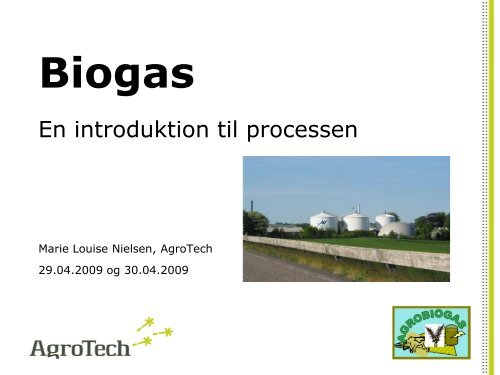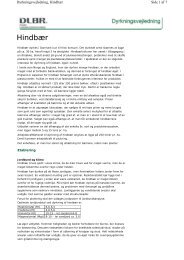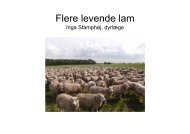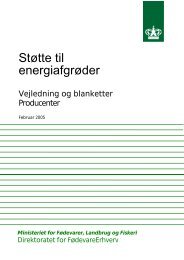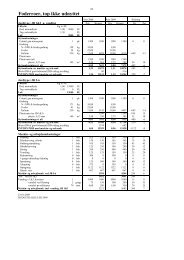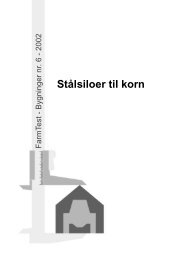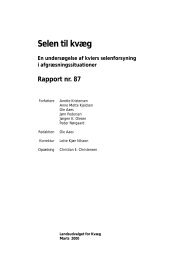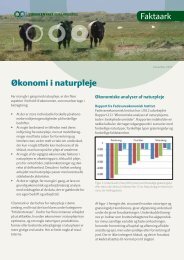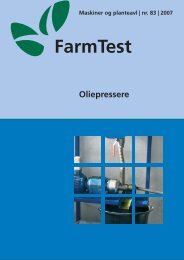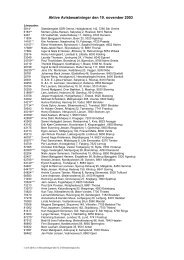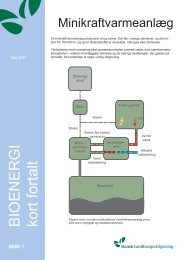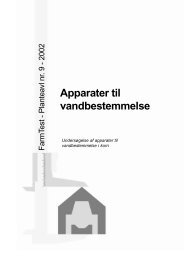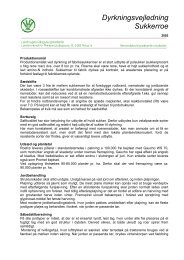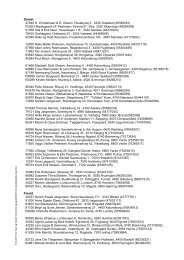Hvad er biogas - LandbrugsInfo
Hvad er biogas - LandbrugsInfo
Hvad er biogas - LandbrugsInfo
You also want an ePaper? Increase the reach of your titles
YUMPU automatically turns print PDFs into web optimized ePapers that Google loves.
Biogas<br />
En introduktion til processen<br />
Marie Louise Nielsen, AgroTech<br />
29.04.2009 og 30.04.2009
Indhold<br />
<strong>Hvad</strong> <strong>er</strong> <strong>biogas</strong><br />
Opbygning af <strong>biogas</strong>anlæg<br />
Biomasse og en<strong>er</strong>giudbytte<br />
Mikrobielle process<strong>er</strong> i reaktoren<br />
Drift af <strong>biogas</strong>anlægget, hvilke parametre har betydning for<br />
processen<br />
Model af <strong>biogas</strong>processen
<strong>Hvad</strong> <strong>er</strong> <strong>biogas</strong><br />
Brændbar blanding af gass<strong>er</strong> (CH 4 og CO 2)<br />
Dannes ved ana<strong>er</strong>ob nedbrydning af organisk stof<br />
Metan: 55 – 70 %<br />
Kuldioxid: 30 – 45 %<br />
Sammensætningen af gassen afhæng<strong>er</strong> af hvad d<strong>er</strong> nedbrydes<br />
– Simple sukk<strong>er</strong>stoff<strong>er</strong> giv<strong>er</strong> en lav procentdel af metan<br />
– Fedt giv<strong>er</strong> en høj procentdel af metan<br />
Andre: H 2S, H 2, NH 3, CO, N 2, O 2
Opbygning af et <strong>biogas</strong>anlæg
Biomasse og en<strong>er</strong>giudbytte<br />
Biogas produc<strong>er</strong>es af affaldsprodukt<strong>er</strong><br />
På danske anlæg: 60–80 % gylle og 20–40 % industriaffald<br />
Udbyttet <strong>er</strong> h<strong>er</strong> ca. 35 m 3 <strong>biogas</strong>/m 3 biomasse<br />
Kilde: Pet<strong>er</strong> Jacob Jørgensen, PlanEn<strong>er</strong>gi<br />
Udov<strong>er</strong> <strong>biogas</strong> dannes næringsrig gødning.
Mikrobielle process<strong>er</strong> i reaktoren<br />
Ana<strong>er</strong>ob nedbrydningsproces: Organisk mat<strong>er</strong>iale (kulhydrat,<br />
protein og fedt) nedbrydes uden ilt.<br />
Kompleks proces hvor fl<strong>er</strong>e bakt<strong>er</strong>iegrupp<strong>er</strong> arbejd<strong>er</strong> sammen.<br />
Den mikrobielle proces består af tre trin:<br />
- 1. Hydrolyse<br />
- 2. Syredannelse (gæring, f<strong>er</strong>mentation)<br />
- 3. Metandannelse
Kulhydrat, protein, fedt<br />
Sukk<strong>er</strong>, aminosyr<strong>er</strong>, fedtsyr<strong>er</strong><br />
VFA<br />
Acetat H 2, CO 2<br />
3<br />
2<br />
1<br />
CH 4 + CO 2<br />
3
Drift af <strong>biogas</strong>anlægget<br />
Bakt<strong>er</strong>i<strong>er</strong>ne i reaktoren skal have optimale betingels<strong>er</strong><br />
Parametre som har betydning for dette:<br />
- Reaktoren<br />
- Temp<strong>er</strong>atur<br />
- Surhedsgrad (pH)<br />
- Hæmning
Reaktoren<br />
Ana<strong>er</strong>obt miljø – metanbakt<strong>er</strong>i<strong>er</strong> tål<strong>er</strong> ikke ilt<br />
Omrøring <strong>er</strong> vigtig for at undgå uigennemtrængeligt flydelag<br />
Opholdstiden skal være lang nok til at bakt<strong>er</strong>i<strong>er</strong>ne ikke vaskes<br />
ud<br />
Fød<strong>er</strong>aten bestemmes af metanbakt<strong>er</strong>i<strong>er</strong>nes væksthastighed<br />
– 1 – 6 Kg COD pr. m3 reaktorvolumen pr. dag<br />
– Vigtigt med jævn og ensartet tilførsel af biomasse<br />
Findeling af biomassen<br />
Tørstofindhold 8 – 10 %
Temp<strong>er</strong>atur<br />
Biokemiske process<strong>er</strong> forløb<strong>er</strong> hurtig<strong>er</strong>e, jo høj<strong>er</strong>e<br />
temp<strong>er</strong>aturen <strong>er</strong><br />
Fordobling af hastigheden for hv<strong>er</strong> 10 °C<br />
Forskellige bakt<strong>er</strong>i<strong>er</strong> <strong>er</strong> tilpasset forskellige temp<strong>er</strong>atur<strong>er</strong><br />
- Psykrofile: 0 - 20 °C<br />
- Mesofile: 30 – 45 °C<br />
- T<strong>er</strong>mofile: 55 – 75 °C<br />
Nedbrydningsraten <strong>er</strong> højest und<strong>er</strong> t<strong>er</strong>mofile forhold, d<strong>er</strong>for<br />
kan reaktoren klare m<strong>er</strong>e belastning ell<strong>er</strong> lav<strong>er</strong>e opholdstid<br />
Bakt<strong>er</strong>i<strong>er</strong>ne tål<strong>er</strong> ikke svingning<strong>er</strong> i temp<strong>er</strong>aturen
Surhedsgrad (pH)<br />
Stor indflydelse på bakt<strong>er</strong>i<strong>er</strong>nes vækst<br />
Optimal pH<br />
– Mesofile: 6,7 – 7,4<br />
– T<strong>er</strong>mofile: 8<br />
Lav pH: ophobning af VFA<br />
Høj pH: ophobning af ammoniak<br />
Optimal pH opnås ved balance i processen<br />
Stor buff<strong>er</strong>kapacitet i reaktoren giv<strong>er</strong> stabilt system
Hæmning af <strong>biogas</strong>processen<br />
Kvælstofhæmning<br />
– D<strong>er</strong> dannes ammoniak (NH 3) ved nedbrydning af<br />
kvælstofholdige stoff<strong>er</strong>, fx protein<strong>er</strong><br />
– Høje koncentration<strong>er</strong> <strong>er</strong> giftigt for bakt<strong>er</strong>i<strong>er</strong>ne<br />
– Bakt<strong>er</strong>i<strong>er</strong>ne kan langsomt tilvænnes til et høj<strong>er</strong>e niveau<br />
Forsuring<br />
– Hæmning pga. ophobning af organiske fedtsyr<strong>er</strong> (VFA)<br />
Antibiotika o.l.<br />
– Anvendes i husdyrproduktion til behandling af syge dyr og<br />
desinfektion<br />
– Mængd<strong>er</strong>ne <strong>er</strong> små og bakt<strong>er</strong>i<strong>er</strong>ne kan vænnes til<br />
stoff<strong>er</strong>ne
Model af <strong>biogas</strong>processen<br />
Til brug for fx rådgivning om opstart af <strong>biogas</strong>anlæg<br />
B<strong>er</strong>egn<strong>er</strong> <strong>biogas</strong>udbyttet fra tilgængelige substrat<strong>er</strong><br />
Input:<br />
– Substrat<strong>er</strong> (fx gylle, majs, halm, kageaffald m.m.)<br />
– reaktordesign og indstilling<strong>er</strong><br />
Output:<br />
– Biogasudbytte<br />
– % metan i <strong>biogas</strong><br />
– 69 andre paramtre (fx pH, NH3, acetat)
Model af <strong>biogas</strong>processen
Model af <strong>biogas</strong>processen
Model af <strong>biogas</strong>processen<br />
Eksempel 1:<br />
Svinegylle og<br />
majs
Model af <strong>biogas</strong>processen<br />
Eksempel 2:<br />
Svinegylle,<br />
halm og æbl<strong>er</strong>
Model af <strong>biogas</strong>processen<br />
Eksempel 3:<br />
Majs
Model af <strong>biogas</strong>processen<br />
Eksempel 3:<br />
Majs<br />
pH fald<strong>er</strong>
Model af <strong>biogas</strong>processen<br />
Eksempel 3:<br />
Majs<br />
VFA stig<strong>er</strong>


